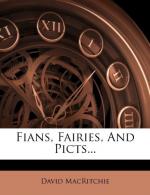In connection with the identification of this mound with the “Brugh of the Boyne” of ancient Irish history, the following remarks may be quoted. The Rev. Father O’Laverty, in the Journal of the Royal Society of Antiquaries of Ireland (December, 1892, p. 430) thus observes:—
“In his very valuable work, The Boyne and Blackwater, Sir William Wilde appears to me to have used convincing arguments to prove that Brugh-na-Boinne ... was ... on the left bank of the Boyne, convenient to the ford of Ros-na-righ (Rossnaree) at Knowth, Dowth, and Newgrange. To Sir William’s arguments one point only was wanting: the old name had disappeared.... It is now more than thirty years since I went to Newgrange for the special purpose of investigating that matter. I explained to Mr. Maguire, then of Newgrange, and to his son, that Brugh-na-Boinne signified ’the town, or dwelling-place, on the Boyne,’ that the word Brugh would assume the modern form Bro, as in Brughshane (pronounced Broshane), and many other townland names, and that na-Boinne, ’of the Boyne,’ would probably cease to be used as unnecessary at the site. I need not say that I was greatly pleased when they informed me that the field in which is the mound of Newgrange is called the Bro-Park, while in the immediate vicinity are the Bro-Farm, the Bro-Mill, and the Bro-Cottage.” [And also, they might have added, the mansion of Broe House.]
Any one, therefore, who duly considers the matter, in relation to the statements of both of these writers, will see that the mound at New Grange is the Brugh-na-Boinne of Irish history and tradition. And this name, says Father O’Laverty, “signified ’the town, or dwelling-place, on the Boyne.’” What, then, are the earliest associations with this “town or dwelling-place?”
It is said[78] to have been built by a celebrated “king and oracle” of the people known as the Tuatha De, Dea, or De Danann, and to have been the residence of himself and others of his race. This chief (Eochaid Ollathair) is usually referred to as “the Dagda,” or “the Daghda Mor”; and of his nation it is asserted that, after having invaded Ireland and conquered its native “Fir-Bolgs,” they were themselves conquered in turn by a later race of immigrants, the Gaels. This “Brugh,” therefore, is said to have been the residence of the Dagda, and, after him, of Angus, one of his sons. Consequently, it is very frequently styled “the Brugh of Angus, son of the Dagda,” an appellation which assumes various forms.[79] Latterly, it seems to have been most generally known as “the Brugh” (par excellence), or, more simply still, as “Brugh.” In the Book of Leinster it is specified as one of “Ireland’s three undeniable eminences [dindgna]"[80]; while “an ancient poem by Mac Nia, son of Oenna (in the Book of Ballymote, fol. 190 b.),” styles it “a king’s




